If you ever spot a large polyp stony (LPS) coral that put you in mind of peppermint, you encountered the candy cane coral (Caulastraea furcata).
The striped patterns stand out in any reef tank, drawing the eye and reminding people of their favorite minty treat.
Candy cane corals also sport a fluted shape, giving rise to their other common name of trumpet corals. (You may also see them labeled as torch corals, though you don’t want to mistake them for that aggressive Euphyllia species)

Known as a “bulletproof” coral, candy canes endure through plenty of those first saltwater aquarium mistakes novice aquarists might make.
This makes them popular with everyone. And while it isn’t permission to slack on care, at least you know they’ll survive an “oops” moment.
At a Glance
- Tank Size: Do well in any size, even nano tanks
- Temperature: 72-78F (22-25.5C)
- pH:8.1-8.3
- Hardness: 8-11 dH
- Lighting: Moderate
- Water Flow: Moderate
- Size: Up to 6 inches (15 cm)
- Specific Gravity: 1.022-1.025
- Ammonia: 0 ppm
- Nitrite: 0 ppm
- Nitrate: < 10 ppm
- Calcium: 350-450 ppm
- Magnesium: 1200-1350 ppm
- Phosphorous: 0 ppm
[toc]
Appearance
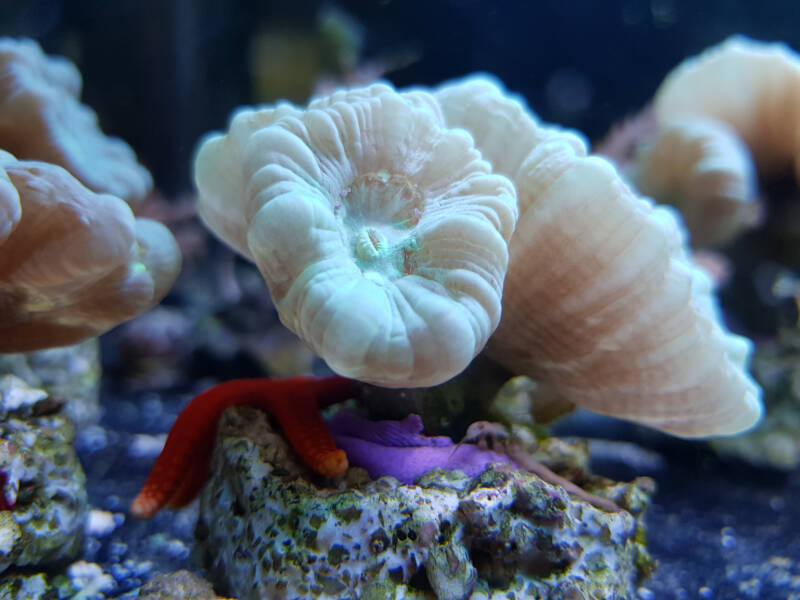
The pale stripes that surrounded the solid-colored center of candy cane corals led to their common name. (And it holds for the other popular name of bullseye coral)
They usually come in shades of green, yellow, or blue (in the wild).
However, courtesy of their popularity, aquarists have experimented with selective breeding. And now you can find candy canes in almost any color you can think of.
Even better, if you get these corals under black lighting, they fluoresce a brilliant neon.
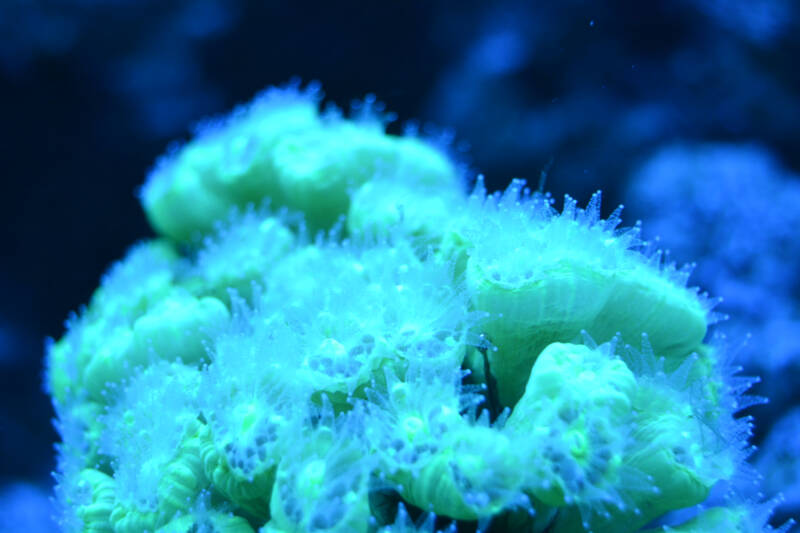
Candy cane corals come in two different varieties based on their growth pattern: dome and branching.

Dome candy canes grow from a clustered base, gradually building up and out. They produce a rounded growth of the striped polyps in a (you guessed it) dome shape.
More often, though, aquarists lean towards branching candy canes.
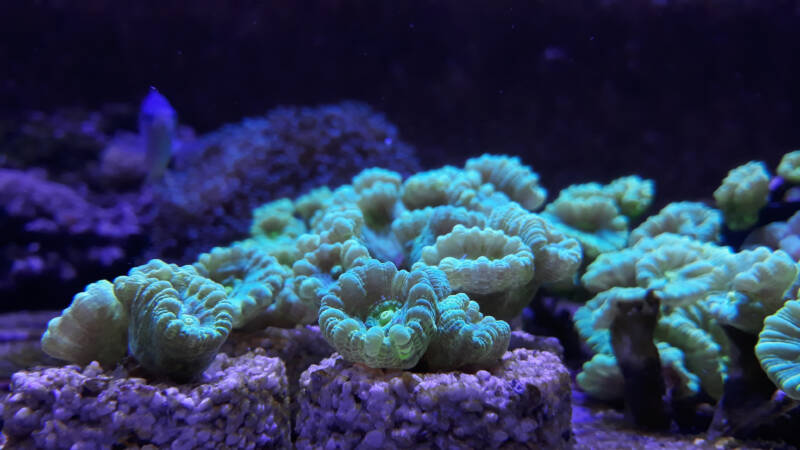
When the polyps divide, they reach out from one another to take advantage of the available space around them. It’s the more popular variety of the species.
In the Wild
Candy cane corals pop up throughout the Indo-Pacific. They pop up around Australia, Fiji, the Maldives, Seychelles, the Solomon Islands, and Tonga.
The tropical reef environment allows these quick-growing corals to thrive.
Unlike some LPS corals, candy canes prefer sand for their substrate.
Their growth pattern – and the orientation of their polyps – prevents any damage from the grainy texture. It also provides them with less competition.
You’ll find candy cane corals in protected regions of the reef, usually in shallower waters and tide pools.
Divers have come across candy canes as deep as 100-130 feet (30-40 m). However, it isn’t uncommon for them to drift deeper.
With their compact base structures (and a short sweeper tentacle), candy cane corals make themselves at home among common reef structures.
They cluster within colonies of sessile mollusks, sponges, and zoanthids.
Caring for Candy Cane Coral
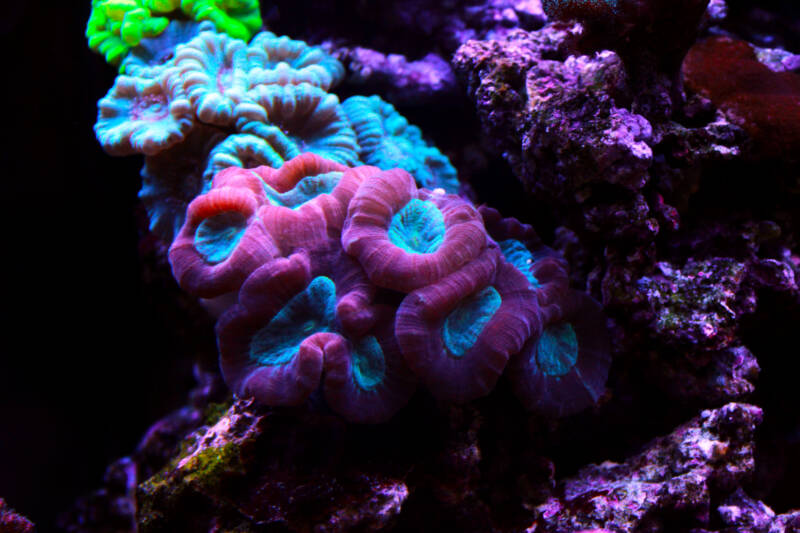
Aquarists love candy cane corals due to their undemanding reputation. The species is also beginner-friendly.
If you happen to lose track of your tank’s salinity or calcium for a few days, these corals will survive.
You also have more freedom in their placement, lighting, and water movement than you see with other LPS species. They’ll adapt.
It doesn’t mean you shouldn’t aim to meet their demands, of course.
But if you’re learning the ropes, candy canes will endure through the adjustments.
Tank Size
Candy cane corals are one of the fastest-growing species out there.
As long as you have the right tank conditions and offer a healthy supplemental diet? They’ll thrive.
But that doesn’t mean you need to rush out and splurge on a massive tank.
The average candy cane sold (as a maximum) by fish stores is around 6 inches (15 cm). But they also come much smaller.
And the species tolerates placement in ANY size of tank. That includes a nano tank.
If you have a saltwater aquarium you’d like to add candy cane coral to, you’re probably in the clear.
As long as you offer a patch of at least 6 inches (15 cm) in diameter, you’re good. That provides room for your coral to grow without a worry about sweeper tentacles.
Water Conditions
You should attempt to stick to standard saltwater aquarium water parameters.
That will ensure the health of your candy canes. And that means keeping a balance of calcium (350-420 ppm), so they can continue to grow.
While candy canes DO count as “bulletproof,” you should still keep an eye on your nitrates.
They’ll only tolerate up to 10ppm. After that, you need to perform a water change. (Or check the state of your filters)
You should also watch your phosphate level. Candy cane corals won’t tolerate a phosphate level above 0.10 ppm.
If you’re getting close to that threshold, it’s time to check your media reactor. It might be time to replace things.
Lighting
Candy cane corals look fantastic under moon lights.
However, you can’t keep them under that soft glow all the time if you want them to survive.
They’ll tolerate low lighting, but not THAT low. (Yes, the neon glow is cool, but we’re talking health needs)
You want to look for lighting in the moderate range (100-150 PAR). Nothing “white-hot,” or you could end up forcing the polyps to retract.
If you see those trumpets curl in, you know that you need to make adjustments – either in intensity or their placement.
If you need stronger lighting for other corals in your reef tank, try moving your candy canes to the outer edge of the light. This will soften the intensity they receive.
You can also move the corals lower in the water column for the same effect.
Water Flow
When it comes to water flow, candy cane corals are flexible. They’ll tolerate a fairly wide range, though that “sweet spot” in the middle usually works best.
You’ll want the ability to adjust your wavemaker over time to find the perfect Goldilocks flow.
Unlike other coral species, you’re not necessarily looking for a polyp response with water flow.
Sure, a higher flow will help pull excess mucus from their tentacles, but that’s not the entire story. You’re looking at something else.
How you set the tank’s current is dependent on how much you plan to feed your candy canes.
If you have a regular feeding schedule, you can keep things lower. They won’t need to catch as much themselves.
But if you’re not going to feed them? The coral needs a higher water flow.
Placement
Some people refer to candy cane corals as “non-aggressive.”
This is a bit of a misnomer. Or, more accurately, it’s due to a misunderstanding.
It isn’t that the species ISN’T aggressive; it’s more like they lack the abilities of other LPS corals.
Candy canes have sweeper tentacles that are MUCH shorter than most corals – only about 2-3 inches (5-7.6 cm) long.
However, the nematocysts (stinging cells) on those short tentacles pack a WHALLOP. And it’s stronger than corals with longer sweeper tentacles.
However, the candy cane can’t reach unless a neighboring coral is basically on top of them.
And that’s why people start to consider them harmless. It isn’t true, though, and you still need to respect a proper perimeter in your placement.
Luckily, candy cane corals have more flexibility in their placement than their LPS cousins.
You can set them up on the sand without a worry. And if they’re far from the light?
They won’t mind. It gives you more options than you find with other species.
Candy Cane Coral Tank Mates
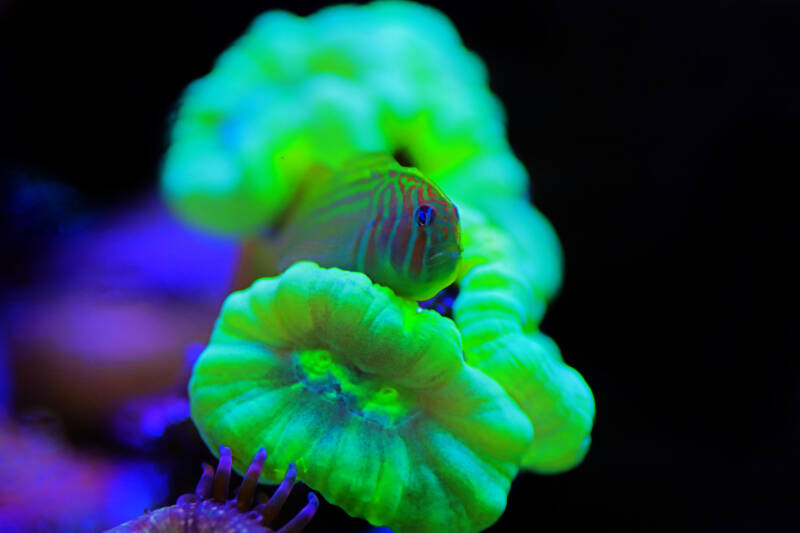
Candy cane corals pop up among plenty of other sedentary species on reefs.
And since they DON’T have long sweeper tentacles, they’re ideal for adding to the average reef tank. (Provided you give them space) Their colors and shape add a unique touch.
They don’t present many of the problems you can see with more delicate polyps.
And their habit of popping up among sessile neighbors works to your advantage. That means you can pair them with any of the following:
- Clams
- Clownfish
- Feather dusters
- Firefish
- Gobies
- Shrimp
- Sponges
- SPS corals
- Starfish
- Tangs.
Obviously, you don’t want your candy canes to get too close to aggressive LPS corals. Especially if they have LONG sweeper tentacles.
A candy cane might be able to hold its own with that punch of stinging cells, but it’s better not to rock the boat.
And it’s never a good idea to introduce fish or crustaceans with a penchant for nibbling or picking at polyps.
The fluted shape isn’t as delicate as some of the tentacles out there, but it can still suffer damage. So avoid these groups:
- Acan corals
- Angelfish
- Butterflyfish
- Crabs
- Frogspawn coral
- Hammer coral
- Parrotfish
- Peppermint shrimp
- Torch coral.
Feeding Candy Cane Coral

Target feeding is the way to go if you want your candy cane corals to grow as fast as possible (or you want to keep your water flow down).
It’ll encourage them to bud, and it’ll provide you with the best coloration for the corals. To target feed, pick up a helpful feeding tool:
- Julian’s Thing
- Sea Squirt
- Turkey baster (just one the one you use around the house).
If you want to know more we have a detailed guide about coral food and nutrition.
Candy canes are VORACIOUS eaters. They’ll happily consume anything you offer.
But there’s a slight catch: these corals are nocturnal. So you’ll need to wait until the evening hours (or turn the lights off) before you decide to feed them.
Offering food 2-3 times a week will keep your candy cane coral happy.
Watch them as they eat, though, as your fish and crustaceans often grow wise to the addition of food to the tank. And they’re not above stealing.
You should also distract those tank mates while you’re at it.
Shrimp and crabs learn to irritate candy cane corals after meals. This prompts the coral to “spit out” ingested food. It means sacrificing some time, but you’ll keep your coral fed and happy.
Types of Food
Candy cane corals aren’t picky about the kinds of food you offer. When those tentacles sense food in the area, they’ll stretch out.
You want to choose a high-quality variety, though. It will keep them the healthiest and plump up those colors:
- Amphipods or copepods
- Commercial fish foods
- Coral foods
- Enriched brine shrimp
- Mysis shrimp
- Prawns.
Candy Cane Coral Reproduction
Watching candy cane corals divide is fascinating. You’ll see the budding process start when the “mouth” splits in two.
The polyp then continues to divide. In no time, a new coral base forms around the addition, and a fresh branch (or section of the dome) spreads out.
Of course, you can also see sexual reproduction in candy canes.
The species is hermaphroditic, with both male and female gametes produced and released into the water column. It’s not as common to see this in the home aquarium, though.
Propagation and Fragging
If you’ve always wanted to learn to frag, candy cane corals are one of the best species for the job.
The long branch of the skeletal base makes it easy to identify individual branches.
They’re also lightweight and brittle, making it easy for ANYONE to break apart.
To frag the coral, all you need is something sharp to cut through that skeleton. (Some people snap the branch, but it’s better to be precise)
You can use wire cutters, bone cutters, or a Dremel tool. Anything that will cut through the stalk – NOT the polyp.
The best place for a cut is where all of the branches of the base connect. You won’t risk cutting into the polyp. (If you cut a polyp, it WILL die)
You don’t need to use a frag plug or rock, either. Candy cane corals do well sitting in the sand.
Anticipated Growth Rates
Candy cane corals have one of the fastest growth rates.
And as long as you leave them alone (i.e., don’t rearrange them), provide a healthy environment, and supplement them with extra food, you’ll see budding in no time.
Candy Cane Coral Health
“Bulletproof” or not, candy cane corals require SOME attention to their living conditions.
They’re not immune to problems. However, they’ll happily let you know there’s an issue you need to address.
A retracted polyp is an unhappy polyp. This could be due to incorrect lighting conditions, problems with tank mates, or improper water conditions.
If you do not see those tentacles emerge in the evening, you need to do some investigating.
The same with a candy cane coral that loses its stripes. You picked the species for those iconic markings, and now it’s losing its color.
That’s usually an indication that the lighting’s too low or your water conditions have slipped. It’s time to check both.
Candy Cane Coral: Are They For You?
Candy cane corals usually start around $30-$60. Of course, that depends on the color variety and size of the colony you’re looking at.
As the frag goes up in size (or you look at rarer colors), you can quickly go into the $150 range.
Keep in mind that even the more “common” shades of candy cane will fluoresce neon under moon lighting.
It’s a nice compromise if you don’t want to splurge for a rare variety. And it’ll add a punch of personality to your tank.
Simple Striped LPS Corals
Candy cane corals add a touch of whimsy with their striped, fluted polyps.
And that “forgiving” nature regarding their care?
It’s what draws in aquarists starting their first reef tanks. Just watch for those powerful – albeit – short sweeper tentacles. These candy canes pack a punch!
Do you have candy cane corals? What color variety’s your favorite?
Have you encountered any aggression problems?
Please share your questions and stories here!
